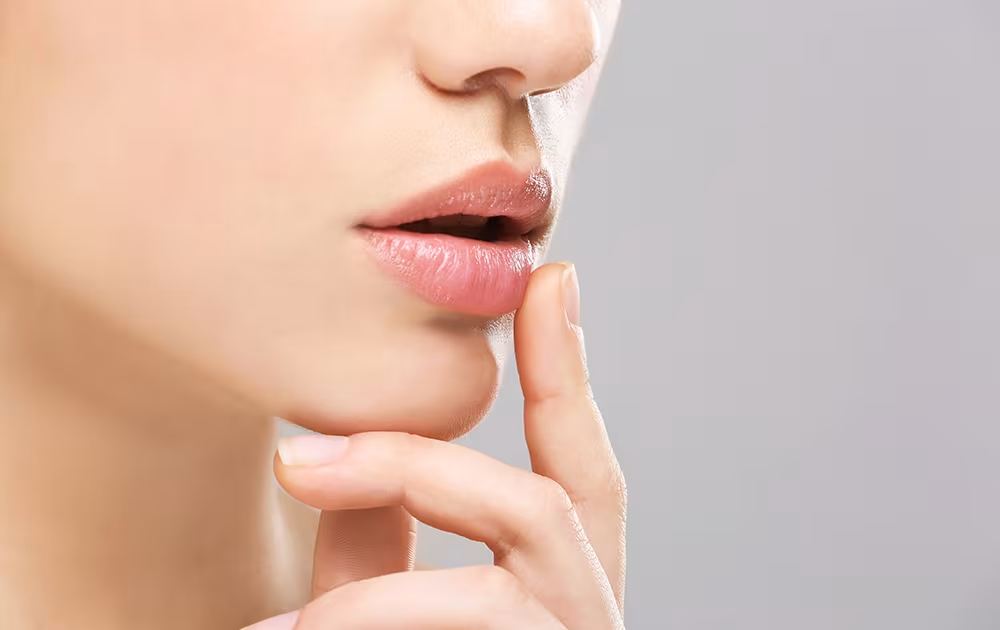
Have you recently had a lip lift procedure and are now wondering about the scar it left behind? While this cosmetic procedure can beautifully enhance the shape and balance of your lips, many patients are left concerned about visible scarring and what they can do to improve it.
Fortunately, with today’s advanced scar management techniques and a clear understanding of the healing process, lip lift scars can become significantly less noticeable over time. If you’re eager to improve your results or considering a revision, read on to learn more.
How Long for Lip Lift Scar to Heal?
Lip lift scars typically take around one year to fully mature and heal. However, noticeable improvement in appearance, such as fading, softening, and flattening, can begin within just a few weeks. It’s important to remember that scars are permanent, but their visibility can be drastically reduced with proper post-operative care and targeted treatments. We’ll explore these in more detail below.
Lip Lift Scar Healing Time
Understanding how a lip lift scar evolves over time can help set realistic expectations and guide your recovery journey. Below is a breakdown of the typical healing timeline so you know what changes to expect at each stage and when you might consider additional treatment or intervention.
1 Week Lip Lift Scar
During the first week after surgery, the scar will be fresh and likely appear red, slightly raised, and possibly swollen. You may also notice mild bruising and scabbing along the incision line. This is a critical time for healing, so keeping the area clean, avoiding tension on the upper lip, and following your surgeon’s care instructions is essential.
During the first week…
2-3 Weeks Lip Lift Scar
By the second or third week, most of the initial swelling and bruising will have resolved. The scar may still appear red or pink, but scabbing should be gone, and the incision line will begin to flatten slightly. Some itching or tightness is normal as new tissue forms. Consistent use of ointments or silicone gel can support smoother healing during this stage.
By the second or third week…
1-Month Lip Lift Scar
At one month post-op, the scar will likely look less red and begin to blend more naturally with the surrounding skin. While it may still be visible up close, many patients notice the incision line becoming flatter and smoother. At this point, gentle massage and continued use of silicone-based products can aid further scar softening and maturation.
At one month post-op…
2-3 Months Lip Lift Scar
By the 2–3 month mark, most scars have significantly improved in texture and color. The incision line may appear light pink or slightly darker than your natural skin tone, but this typically continues to fade. This is also the time when your surgeon may recommend starting treatments like microneedling or laser therapy, depending on how the scar is progressing.
By the 2–3 month mark…
4-6 Months Lip Lift Scar
At this point, most scars are well into the maturation phase. The scar should be flatter and much less red, though it may still have a slightly different tone compared to the surrounding skin. Any residual texture or tightness should continue to improve gradually. If the scar still appears prominent, this may be a good time to consider targeted treatments with your specialist.
Well into the maturation phase…
Lip Lift Scar Beyond Year 1
After one year, the lip lift scar is considered mature. By now, it should be relatively flat and may have faded to match your natural skin tone or remain slightly lighter or darker. While it won’t disappear completely, its visibility can often be minimal. For patients still concerned about its appearance at this stage, revision treatments such as scar resurfacing or camouflage techniques may offer excellent results.
The final results…
Tips for Better Scar Healing and Results During Recovery Time
Taking care of your skin to ensure a proper healing process can have a significant impact on the final appearance of your scar. Below are some of the best practices to support optimal recovery from lip lift and wound healing.
Wound Care and Dressing
Proper daily wound care is essential in the early stages of healing to prevent infection and support optimal scar formation. Patients should follow their surgeon’s cleaning and dressing instructions carefully, typically involving gentle cleansing and application of antibiotic ointment. Avoid picking at scabs or disturbing the incision site, as this can lead to poor healing or more noticeable scarring.
Diligent Sun Protection
Exposure to UV rays can cause a healing scar to darken and become more noticeable. That’s why sun protection is crucial during the recovery process. Patients should apply a broad-spectrum sunscreen with SPF 30 or higher to the area daily—even on cloudy days—and consider wearing a wide-brimmed hat or seeking shade whenever outdoors to protect the delicate healing skin.
Avoid Smoking and Alcohol
Smoking and alcohol consumption can significantly hinder the healing process and negatively affect scar appearance. Nicotine restricts blood flow, which limits oxygen and nutrient delivery to healing tissues, while alcohol can increase inflammation and impair immune function. For the best possible aesthetic outcome, it’s recommended to avoid both, especially in the critical early weeks after surgery.
Follow Surgeon’s Instructions
One of the most important steps for proper scar healing is closely following your surgeon’s post-operative instructions. These may include specific guidance on cleaning the lip area, applying products, and activity restrictions to avoid strain on the incision. Consistency and attention to detail in your aftercare routine can make a significant difference in how well your scar heals and fades over time.
How to Get Rid of Lip Lift Scars
Modern cosmetic treatments offer a wide range of options to reduce the appearance of lip lift scars. From surgical refinements to non-invasive therapies, each option has its own set of benefits depending on your unique case and scar maturity.
Lip Lift Revision Surgery
Lip lift revision surgery is a corrective procedure performed to improve the appearance of an existing scar from a previous lip lift. This scar repair option is typically recommended for patients whose scars have healed poorly, remained raised or highly visible, or caused functional concerns. The surgeon may excise the old scar and carefully reclose the incision with refined suturing techniques to produce a cleaner, more discreet result. Depending on the extent of revision needed, the surgery can be performed under local anesthesia or general anesthesia. Ideal candidates for revision are those who are at least 6–12 months post-op and have a stable, mature scar.
Laser Treatments
Laser treatments use focused light energy to resurface the skin and stimulate collagen production, helping to reduce the appearance of scars. Fractional CO2 and erbium lasers are among the most commonly used for lip lift scars, as they can smooth texture and lighten pigmentation without damaging surrounding tissue. These treatments are typically considered after the scar has had several months to mature and may require multiple sessions for optimal results.
Microneedling Procedure
Microneedling involves the use of tiny, controlled needles to create micro-injuries in the skin, triggering your body’s natural healing response and boosting collagen production. For lip lift scars, this treatment can help smooth out raised or uneven texture and reduce discoloration. Best results are typically seen after a series of sessions spaced several weeks apart, and it’s often used in combination with topical serums or PRP for enhanced outcomes.
Silicone Gels and Sheets
Silicone gels and sheets are topical treatments widely recommended by surgeons for scar management due to their proven ability to flatten and soften raised scars. These products create a protective barrier that helps retain moisture, which is crucial for optimal healing. When used consistently for several weeks or months, silicone scar creams can visibly reduce redness and improve the overall texture of the scar. They are non-invasive, easy to apply, and suitable for the early stages of healing.
Steroid Injections
Steroid injections are often used to treat keloid or hypertrophic scars that become raised, thick, or itchy. These injections work by reducing inflammation and suppressing excessive collagen production, helping to flatten and soften the scar over time. They are typically administered over multiple sessions spaced several weeks apart and are best suited for scars that are resistant to other non-invasive scar treatments.
Scar Camouflage Tattooing
Scar camouflage tattooing, also known as medical micropigmentation, involves implanting pigment into the skin to match your natural skin tone and conceal the appearance of the scar. This technique is best suited for flat, mature scars that are lighter or darker than the surrounding skin. It does not treat the texture of the scar, but can significantly improve its visual blending. Multiple sessions may be needed to achieve optimal color matching and longevity.
Choose the Best Surgeon for Your Scar Revision Surgery
Scar revision is both an art and a science. The success of your treatment depends greatly on the expertise of the surgeon performing it. A skilled and experienced specialist in plastic surgery procedures will understand the intricacies of scar formation, the ideal timing for interventions, and how to choose the right technique for your specific skin and scar type.
Dr. Homer Hojjat is a double-board-certified facial plastic surgeon and otolaryngologist-head and neck surgeon. A respected member of the CSFPS, Dr. Hojjat is known for using the most advanced, minimally invasive techniques to achieve refined, natural results, being an expert in many types of lip lift surgery and facelift procedures. His extensive research background in cosmetic treatment outcomes ensures that each procedure is grounded in both science and artistry. Call us at 949-996-3274 or visit our contact page to schedule a consultation with an experienced plastic surgeon and get all your questions answered.





